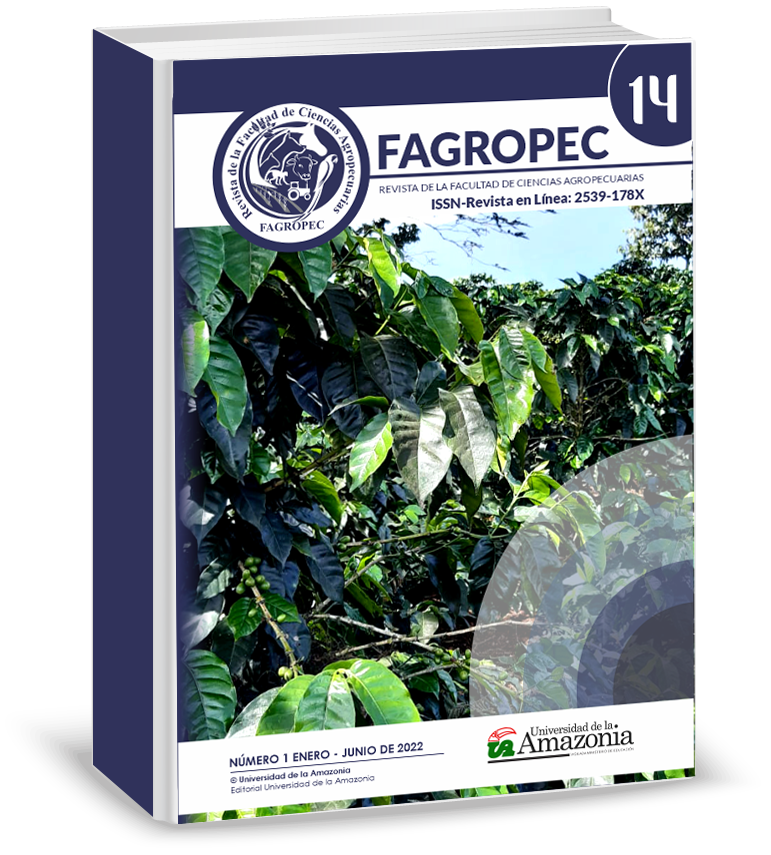REPORTE DE CASO: MACROADENOMA HIPOFISIARIO FUNCIONANTE EN BOSTON TERRIER
DOI :
https://doi.org/10.47847/fagropec.v14n1a8Mots-clés :
Cushing, adenoma, resonancia magneticaRésumé
Un canino macho reproductor Boston Terrier de 8 años de edad fue presentado a San Miguel Medicina Veterinaria, con historial de 6 meses de cambios de temperamento, letargia marcada y alteración en funcionalidad hepática con tratamiento en otro centro veterinario. El paciente presentaba aumento en transaminasas hepáticas ALT y GGT, alteracion ecográfica sobre glándulas adrenales con aumento de tamaño, se plantea diagnostico de hiperadrenocortisismo mediante test de supresión con dexametasona a dosis bajas con aumento de cortisol; se confirma su causa mediante Resonancia Magnetica contrastada cerebral en la que se evidencia masa pituitaria; conllevando al diagnostico adenoma hipofisiario productor de ACTH, se contrastan sus signos clinicos con lo hayado en literatura y alternativas terapeuticas.
Téléchargements
Références
Chang H., Perales C., R., & Tabacchi N., L (2017). Frecuencia de Neoplasias en Caninos de 0 a 5 Años Diagnosticadas en el Laboratorio de Histopatología Veterinaria de la Universidad Nacional Mayor de San Marcos (2003-2014). Revista de Investigaciones Veterinairas Lima, Perú: Rev Inv Vet Peru, Vol 28, N°4, 2017. https://doi.org/10.15381/rivep.v28i4.13867
Membiela – Sánchez F., Coscollá – Palmer A., Borrego – Massó J.F. (2019) Urgencias oncológicas. Clin. Vet. Peq. Anim. Vol 39, N°1.
Horta R.S., Martins B.D., Lavalle G.E., Costa M.D., De Araújo R.B. (2013) Neoplasias intracranianas em pequenos animais-Revisão de literatura. Acta Vet. Brasilica; 7(4):272-281
Freeman, P. M., & Ives, E. (2020). A practical approach to neurology for the small animal practitioner A practical approach to neurology for the small animal practitioner. Wiley-Blackwell.
Menchetti, M., De Risio, L., Galli, G., Bruto Cherubini, G., Corlazzoli, D., Baroni, M., & Gandini, G. (2019). Neurological abnormalities in 97 dogs with detectable pituitary masses. The Veterinary Quarterly, 39(1), 57–64. https://doi.org/10.1080/01652176.2019.1622819
Behrend ES., (2015). Hiperadrenocorticismo canino. En: EC Feldman, RW Nelson, CE Reusch, et al., eds. Endocrinología canina y felina . 4ª ed. San Luis: Elsevier Saunders: 377 – 451 .
Bennaim, M., Shiel, R. E., & Mooney, C. T. (2019). Diagnosis of spontaneous hyperadrenocorticism in dogs. Part 1: Pathophysiology, aetiology, clinical and clinicopathological features. Veterinary Journal (London, England: 1997), 252(105342), 105342. https://doi.org/10.1016/j.tvjl.2019.105342
Nelson, R. W., Ihle, S. L., & Feldman, E. C. (1989). Pituitary macroadenomas and macroadenocarcinomas in dogs treated with mitotane for pituitary-dependent hyperadrenocorticism: 13 cases (1981-1986). Journal of the American Veterinary Medical Association, 194(11), 1612–1617. https://europepmc.org/article/med/2753785
Dewey, C. W., & da Costa, R. C. (2015). Practical guide to canine and feline neurology (Curtis W. Dewey & R. C. da Costa, Eds.; 3a ed.). Standards Information Network. https://books.google.at/books?id=JSWJCgAAQBAJ
Garosi, L., & Lowrie, M. (2013). The neurological examination. En BSAVA Manual of Canine and Feline Neurology (pp. 1–24). British Small Animal Veterinary Association.
Platt, S. y Olby, N. (2013). Urgencias neurológicas. BSAVA manual de neurología canina y felina , 388-408.
Ettinger, S. J., & Feldman, E. C. (2006). Tratado de medicina interna Veterinaria, 2 vols. (E-dition + CD-Rom): Enfermedades del perro Y El Gato (6a ed.). Elsevier.
Vicente, A. (2016) Radiocirugia hipofisiaria con gamma knife en perros con tumor hiperadrenocorticismo hipofisiario. Tesis Doctoral. Madrid, España: Universidad Complutense de Madrid, 2016.
Chaves, R. O., Feranti, J. P. S., Copat, B., Ripplinger, A., França, R. T., Kommers, G. D., Fighera, R. A., & Mazzanti, A. (2018). Neoplasias encefálicas em 40 cães: aspectos clínico-epidemiológicos e patológicos. Pesquisa veterinaria brasileira [Brazilian journal of veterinary research], 38(4), 734–740. https://doi.org/10.1590/1678-5150-pvb-4962
Rojas Z, D., Palma F, A., & Wohllk G, N. (2008). Manejo de los adenomas hipofisiarios. Revista Chilena de Neuro-Psiquiatría, 46(2), 140–147. https://doi.org/10.4067/s0717-92272008000200009
Clemente M., Campos A., & Yeste D. (2018). Tratamiento prenatal de la HSC. Revista Esp Endocrinología Pediátrica Volumen 9 págs. 26- 29
Tritos, N. A., & Biller, B. M. K. (2019). Current management of Cushing’s disease. Journal of Internal Medicine, 286(5), 526–541. https://doi.org/10.1111/joim.12975
Leal-Cerro, A., Moreno, A. S., Mangas, M. A., Justel, A. L., & Webb, S. (2009). Tratamiento farmacológico y seguimiento del síndrome de Cushing. Endocrinología y Nutrición, 56(4), 187-194.
Boretti, F. S., Holzthuem, J., Reusch, C. E., & Sieber-Ruckstuhl, N. S. (2016). Lack of association between clinical signs and laboratory parameters in dogs with hyperadrenocorticism before and during trilostane treatment. Schweizer Archiv für Tierheilkunde, 158(9), 631-638.
Torres, S. C. (2019). Universidad de chile facultad de ciencias veterinarias y pecuarias escuela de ciencias veterinarias monografía terapias médicas actuales para el tratamiento de hiperadrenocorticismo de origen hipofisiario en perros. Uchile.cl. Recuperado el 25 de noviembre de 2021, de https://repositorio.uchile.cl/bitstream/handle/2250/170694/Terapias-m%c3%a9dicas-actuales-para-el-tratamiento-de-hiperadrenocorticismo-de-origen-hipofisiario-en-perros.pdf?sequence=1&isAllowed=y
Téléchargements
Publiée
Numéro
Rubrique
Licence

Ce travail est disponible sous licence Creative Commons Attribution - Pas d’Utilisation Commerciale - Partage dans les Mêmes Conditions 4.0 International.
























